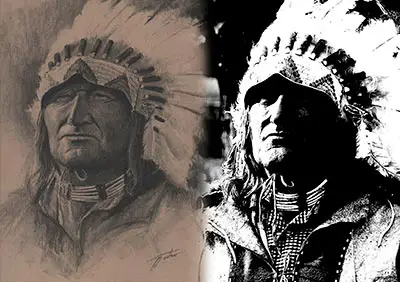
The Most Important Element of Drawing
Seeing the Light
The most important element of drawing, aside from composition, should be the large shapes and the placement of those shapes in proportion to one another. Using portraits as an example, what will make your drawing look most like your subject are the accurate reproduction of the lights and darks, the large shapes that make up the head of the subject, the distance between the eyes, nose, and mouth, overall hairstyle, etc.
Master artist Morgan Weistling makes a good point about likeness and recognition: take your high school yearbook and look at the group photo of the entire graduating class. Even though your classmate’s heads may be no larger in diameter than an eighth of an inch, you can probably still name all your friends in the photo. That’s because details are inconsequential when it comes to recognition. This applies not just to portraits, but to most anything you draw.

To capture these essential shapes, you must simplify the lights and darks in your subject matter to abstract shapes while at the same time suspending in your mind the intellectual names of those objects. So, when looking at a face, you do not draw a nose, an eye, or a mouth. Instead, you draw a particular shape that is so big, has such and such angles, and is a particular distance from the other shape on the page.
The Misconception
You hear it all the time; you may believe it yourself. Someone will see a good painting or drawing and comment, “Wow! Look at the detail!” The concept of detail has a tendency to charm and even seduce artist and non-artist alike. I say the concept of detail because many lovers of detail are incorrect. It’s not the detail that makes something “look like a photograph.” And honestly, while I know that very common saying is meant to be a compliment, if one of my paintings or drawings actually looked just like a photograph, I would probably consider it a failure. I would rather hear a comment such as, “It feels like I’m there,” or “It looks like I could just reach out and touch it.” Those comments come from painting reality as the human eye sees it, not by reproducing all the details captured in a photo. This comes from focusing on the most important element of drawing.




So, what are details? Simply put, they are the little shapes or lines in a subject and work of art. While these little shapes can be charming, they are far from what makes a drawing seem real, and even farther from what makes something a work of art.
The primary emphasis of photographic detail fails because the human eye doesn’t see like a camera does. When you look at the world, your eye focuses on details in only a very narrow range of view. Much of your field of vision is more peripheral and therefore somewhat fuzzy. Therefore, our brain recognizes value and color shapes first, and if you get those shapes and relationships correct, you are much further along.
Details can enhance a drawing, but they should never be the first consideration. Those finely drawn eyelashes don’t mean a hill of beans if the eye is in the wrong place.
Warning: Undefined array key "preview" in /home3/mysketc2/public_html/wp-content/plugins/oxygen/component-framework/components/classes/comment-form.class.php on line 75


Warning: Undefined array key "preview" in /home3/mysketc2/public_html/wp-content/plugins/oxygen/component-framework/components/classes/comment-form.class.php on line 79